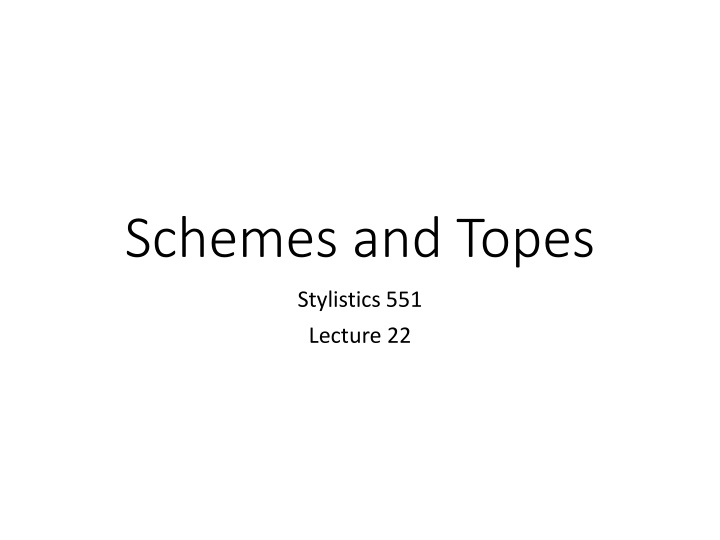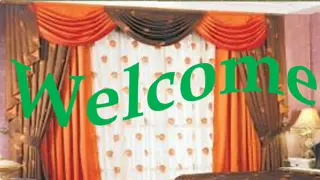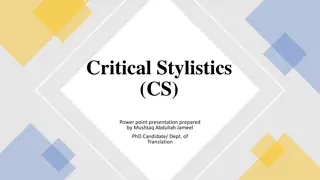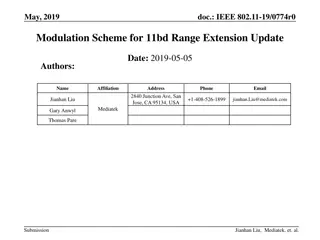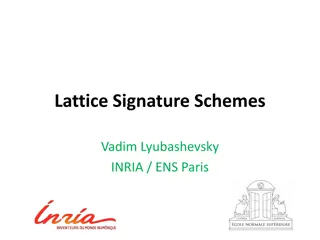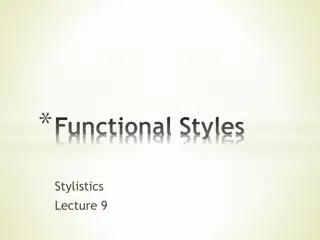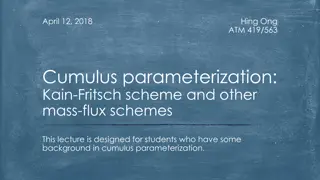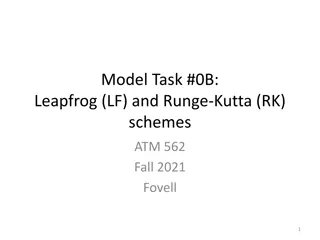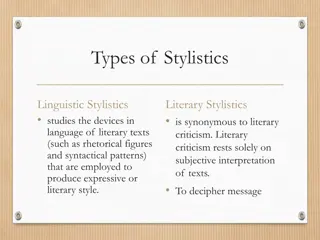Unveiling the Intricacies of Schemes and Tropes in Stylistics
Schemes and Tropes in classical rhetoric play a vital role in enhancing written and spoken language by deviating from literal expressions. These stylistic devices, known as figures of speech, add depth, beauty, and emotional intensity to communication. Schemes involve repetitions of expression, while Tropes consist of irregularities in content. The use of schemes such as alliteration, anaphora, and chiasmus leads to a more forceful and harmonious presentation of ideas. Through examples and explanations, the essence of schemes and tropes in shaping effective communication is elucidated.
Download Presentation

Please find below an Image/Link to download the presentation.
The content on the website is provided AS IS for your information and personal use only. It may not be sold, licensed, or shared on other websites without obtaining consent from the author.If you encounter any issues during the download, it is possible that the publisher has removed the file from their server.
You are allowed to download the files provided on this website for personal or commercial use, subject to the condition that they are used lawfully. All files are the property of their respective owners.
The content on the website is provided AS IS for your information and personal use only. It may not be sold, licensed, or shared on other websites without obtaining consent from the author.
E N D
Presentation Transcript
Schemes and Topes Stylistics 551 Lecture 22
Schemes and Topes In classical rhetoric schemes and Tropes fall under the canon of style. These stylistic features add flavor to writing and speaking. They are persuasive because they dress up commonly mundane language. Schemes and Tropes are rhetorical figures or devices that depart form straightforward, literal language. Figures of speech are often used and crafted for emphasis, freshness of expression or clarity.
Schemes and Tropes It is a mode of expression in which words are used out of their literal meaning or out of their ordinary use in order to add beauty or emotional intensity or to transfer the poet s sense impressions by comparing or identifying one thing with another that has a meaning familiar to the reader. Schemes and Tropes are collectively known as figures of speech, rhetorical devices, stylistic devices.
Schemes Schemes Schemes: foregrounded repetitions of expression. Tropes: foregrounded irregularities of content. Schemes: The word scheme has been derived form the Greek word Schema meaning form or shape . Schemes are figures of speech in which there is a deviation from the ordinary or expected pattern of words.
Schemes roughly have included figures such as alliteration, anaphora, and chiasmus and have been described as abnormal arrangements leading themselves to the forceful and harmonious presentation of ideas. Schemes may be identified as Phonological or formal (i.e. grammatical, lexical pattern)
The following extract contains, a formal level, the repetition of the word farewell; on the phonological level the actual sound of the word farewell is echoed at irregular intervals, and itself constitutes a kind of phonological foregrounding. We listen to it as to the tolling of the bell and audible signal of Othello s surrender of worldly pleasure and achievement:
Farewell the tranquil mind! Farewell content! Farewell the plumed troop and the big wars That make ambition virtue! O, farewell! Farewell the neighing steed and the shrill trump, The spirit stirring drum, the ear piercing fife
The Classification of Figures Because writers turn their word in various ways, literary critics have attempted to analyze and categorize these deviations and parallel structures in the use of words in order to gain better control over the intended thought and feeling of author.
Figures involving Repetition: Figures involving Repetition: Repetition is a major rhetorical strategy for producing emphasis, clarity, amplification, or emotional effect. Within the rhetoric terms have been developed to name both general and very specific sorts of repetition. e.g: And miles to go before I sleep, And miles to go before I sleep
O what can ail thee, knight-at-arms, Alone and palely loitering? The sedge has wither d from the lake, And no birds sing O what can ail thee, knight at arms, So haggard and so woebegone? The squirrel s granary is full, And the harvest done.
Types of Repetition Repetition can be of two types: 1. Repetition of Sounds i) alliteration ii) assonance iii) consonance 2. Repetition of Words i) anaphora ii) apanalepsis iii) epistrophe iv) symploce
1. Alliteration: Is the repetition of initial consonant sound in neighboring words. The matching of repetition of consonants is called alliteration or the repetition of the same letter or sound at the beginning of words following each other immediately or after short intervals. e.g. Now Beowulf bode in the burg of Scyldings, Leader beloved
Alliteration Like rhyme alliteration is great help to memory. It is a powerful device that prose has also borrowed it form poetry. It is alliteration that makes us remember such phrases as: sink or swim do or die live and let live watchful waiting poor but proud hale and hearty green as grass cool as cucumber .
Assonance: assonance is the repetition of vowel sounds e.g. alone alone, all all alone (Coleridge) Consonance: repetition of consonant sound but not at the initial consonant sound. e.g. To toll me back to thee, to my sole self (Keats)
Anaphora Anaphora is a figure of repetition that occurs when the first word or set of words in one sentence, clause or phrase is/are repeated at the beginning of successive phrases, clauses, sentences. This royal throne of kings, this sceptered isle, This earth of majesty, this seat of Mars. It ca be remembered with this formula (a .) (a ) with a symbolizing the consonant element bracket symbolizing the equivalent structure a phrase, clause or a sentence.
2. Epanalepsis Repetition of the same word, clause, or sentence after intervening matter. It is more strictly, repetition at the end of the line, phrase, clause or of the word or set of words that occurred at the beginning of the same line, phrase or clause. (a a) (b b) e.g. With ruin upon ruin, rout on rout, Confusion worse confounded (Paradise Lost, II)
Epanalepsis A lie begets a lie Believe not all you can hear, tell not all you believe
3. Epistrophe: Also called antistrophe is a figure of repetition that occurs when the last word or set of words in one sentence, clause or phrase is repeated one or more times at the end of successive sentence, clauses, or phrases. ( .a) ( .a) Examples: What lies behind us and what lies before us, are tiny as compared to what lies within us Hourly joys be still upon you! Juno sings her blessings on you!
4. Symploce: Symploce is a figure of repetition that combines anaphora and epistrophe in which the first and last word or words in one phrase, clause, or sentence are repeated in one or more successive phrases, clauses or sentences . It is the repetition of the first and last words in a clause over successive clauses. (a b) (a b) Against yourself you are calling him Against the laws you are calling him Against the democratic constitution you are calling him
